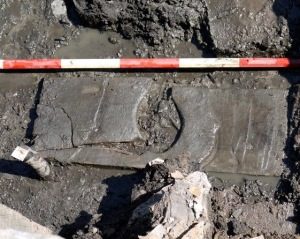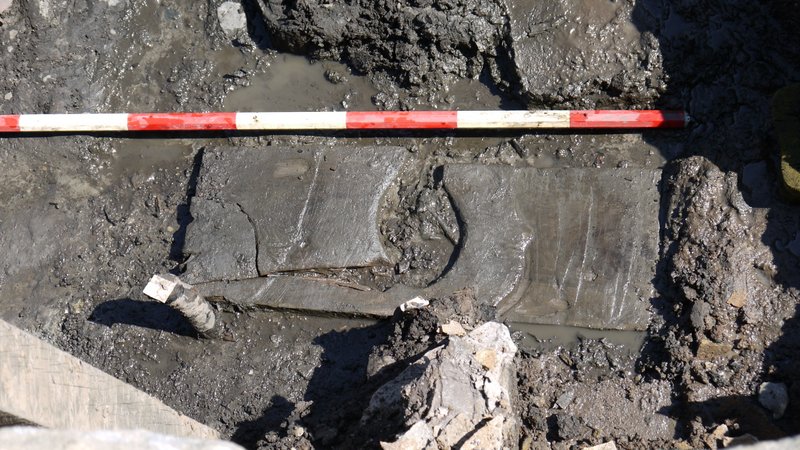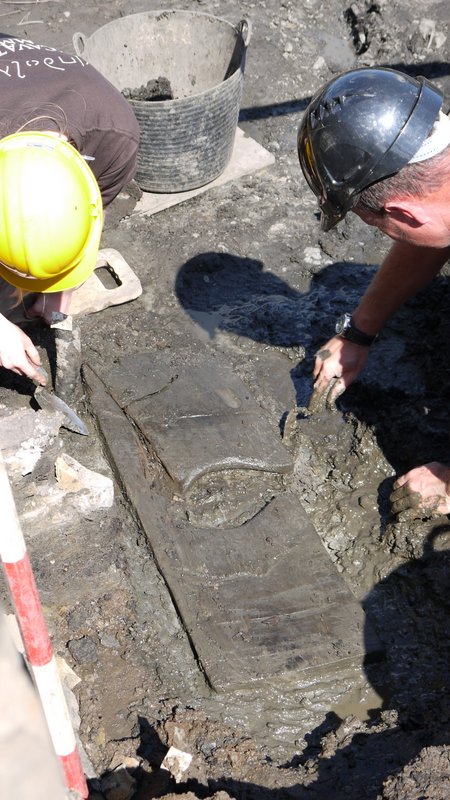
Finding something that one can personally relate to is always a special moment on an archaeological dig. At the 1st-2nd century Roman site of Vindolanda this is a common occurrence, a site where archaeologists have uncovered not only gold and silver and artifacts relating to the military might of the Roman Army, but also everyday items which nearly 2,000 years later have acquired extraordinary value to modern day visitors, volunteers and archaeologists alike. Personal letters, worn shoes, baby booties, socks, combs, jewellery, tools and textiles are just some of the items preserved in remarkable condition, providing a unique window into the lives of people stationed at this most northern outpost of the Roman Empire.
Now archaeologists have discovered another piece of the very personal human hoard at Vindolanda—a wooden latrine (toilet) seat, discovered by the Director of Excavations, Dr. Andrew Birley, in the site’s deep pre-hadrianic trenches. There are many examples of stone and marble seat benches from across the Roman Empire, but this is believed to be the only surviving wooden seat, almost perfectly preserved in the anaerobic, oxygen free, conditions which exist at Vindolanda. Although this wooden seat is not as grand as a marble or stone toilet bench, it would have been far more comfortable to sit on in the cool climate of Britannia. The seat has clearly been well used and was decommissioned from its original purpose and discarded amongst the rubbish left behind in the final fort at the site before the construction of Hadrian’s Wall began in the early second century.
“There is always great excitement when you find something that has never been seen before and this discovery is wonderful….’” said Birley. “We know a lot about Roman toilets from previous excavations at the site and from the wider Roman world which have included many fabulous Roman latrines, but never before have we had the pleasure of seeing a surviving and perfectly preserved wooden seat. As soon as we started to uncover it there was no doubt at all on what we had found. It is made from a very well worked piece of wood and looks pretty comfortable. Now we need to find the toilet that went with it as Roman loos are fascinating places to excavate – their drains often contain astonishing artefacts. Let’s face it, if you drop something down a Roman latrine you are unlikely to attempt to fish it out unless you are pretty brave or foolhardy.” Discoveries at Vindolanda from latrines have included a baby boot, coins, a betrothal medallion, and a bronze lamp.
_________________________________
 The toilet seat still in situ. Courtesy Vindolanda Trust
The toilet seat still in situ. Courtesy Vindolanda Trust
______________________________
 Archaeologists excavating and working on the toilet seat discovery. Courtesy Vindolanda Trust
Archaeologists excavating and working on the toilet seat discovery. Courtesy Vindolanda Trust
_____________________________
Archaeologists now need to find a ‘spongia’, the natural sponge on a stick which Romans used instead of toilet paper. With over 100 years of archaeology remaining along with the site’s unique conditions for the preservation of organic finds, a discovery may be possible.
The wooden seat will take up to 18 months to conserve and once this process is complete the artefact will be put on display at the Roman Army Museum.
Roman Vindolanda is regarded as the most exciting archaeological site in Europe with its wealth of archaeological remains and ongoing excavations. Vindolanda is home to the world famous Vindolanda Writing Tablets. Voted as Britain’s top archaeological treasure by the British Museum, these thin hand-written wooden notes have revealed an astonishing amount of first-hand information about the people who lived at this site 2,000 years ago.
________________________________
Source: Adapted and edited from a press release of the Vindolanda Trust, ‘Earliest known wooden toilet seat discovered at Vindolanda’.
The Vindolanda Trust is an independent archaeological charitable trust, founded in 1970. The Vindolanda Trust does not receive any annual funding and relies on the visitors to both Roman Vindolanda and the Roman Army Museum to fund its archaeological, conservation and education work.
Roman Vindolanda and the Roman Army Museum are both situated in the heart of the Hadrian’s Wall World Heritage Site. Roman Vindolanda is just to the north of the village of Bardon Mill and the Roman Army Museum is next to the village of Greenhead.
________________________________
Travel and learn with Far Horizons.
Read about the most fascinating discoveries with a premium subscription to Popular Archaeology Magazine. Find out what Popular Archaeology Magazine is all about. AND MORE:
On the go? Get the smartphone version of Popular Archaeology as an app or as an ebook.
Popular Archaeology’s annual Discovery Edition eBook is a selection of the best stories published in Popular Archaeology Magazine in past issues, with an emphasis on some of the most significant, groundbreaking, or fascinating discoveries in the fields of archaeology and paleoanthropology and related fields. At least some of the articles have been updated or revised specifically for the Discovery edition. We can confidently say that there is no other single issue of an archaeology-related magazine, paper print or online, that contains as much major feature article content as this one. The latest issue, volume 2, has just been released. Go to the Discovery edition page for more information.







